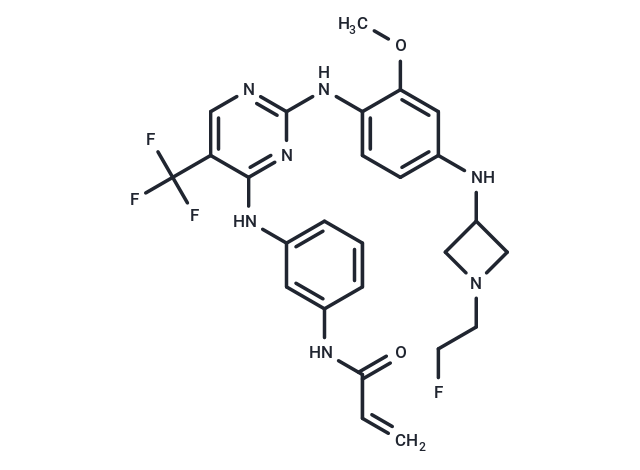Shopping Cart
- Remove All
 Your shopping cart is currently empty
Your shopping cart is currently empty

CNX-2006 is a novel irreversible mutant-selective EGFR inhibitor with IC50 of < 20 nM, with very weak inhibition at wild-type EGFR.

| Pack Size | Price | Availability | Quantity |
|---|---|---|---|
| 1 mg | $34 | In Stock | |
| 2 mg | $48 | In Stock | |
| 5 mg | $76 | In Stock | |
| 10 mg | $128 | In Stock | |
| 25 mg | $235 | In Stock | |
| 50 mg | $425 | In Stock | |
| 1 mL x 10 mM (in DMSO) | $92 | In Stock |
| Description | CNX-2006 is a novel irreversible mutant-selective EGFR inhibitor with IC50 of < 20 nM, with very weak inhibition at wild-type EGFR. |
| Targets&IC50 | EGFR (mutant):<20 nM |
| In vitro | CNX-2006 is a novel irreversible EGFR tyrosine kinase inhibitor, specifically inhibits activating mutations of EGFR as well as the T790M mutation while having very weak inhibition at wild-type EGFR. In in vitro modeling of acquired resistance, continuous CNX-2006 treatment on drug-sensitive EGFR mutant cells leads to resistance more slowly than erlotinib. Dose escalation with CNX-2006 leads to differential effects in different lines, but does not select for T790M-mediated resistance. [1]CNX-2006 resistent cells shows increased expression of EMT markers and MMP9.[2] |
| In vivo | CNX-2006 is effective in H1975 (EGFR L858R/T790M) xenograft model. [1] [2] |
| Kinase Assay | Growth inhibition assays: Human EGFR mutant lung adenocarcinoma cell lines are treated with drugs in standard growth inhibition assays. |
| Cell Research | Cells with endogenous or transiently transfected mutant EGFRs (293 cells) are treated with inhibitors for 6 hours and then corresponding lysates are extracted and analyzed by immunoblotting.(Only for Reference) |
| Animal Research | Animal Models: Nude miceFormulation: 5% DMSO:15% Solutol HS15 in PBSDosages: 25 mg/kgAdministration: i.p. |
| Alias | CNX2006, CNX 2006 |
| Molecular Weight | 545.53 |
| Formula | C26H27F4N7O2 |
| Cas No. | 1375465-09-0 |
| Smiles | COc1cc(NC2CN(CCF)C2)ccc1Nc1ncc(c(Nc2cccc(NC(=O)C=C)c2)n1)C(F)(F)F |
| Relative Density. | 1.396 g/cm3 (Predicted) |
| Storage | Powder: -20°C for 3 years | In solvent: -80°C for 1 year | Shipping with blue ice. | |||||||||||||||||||||||||||||||||||
| Solubility Information | DMF: soluble DMSO: 91 mg/mL (166.8 mM) | |||||||||||||||||||||||||||||||||||
Solution Preparation Table | ||||||||||||||||||||||||||||||||||||
DMSO
| ||||||||||||||||||||||||||||||||||||

Copyright © 2015-2024 TargetMol Chemicals Inc. All Rights Reserved.